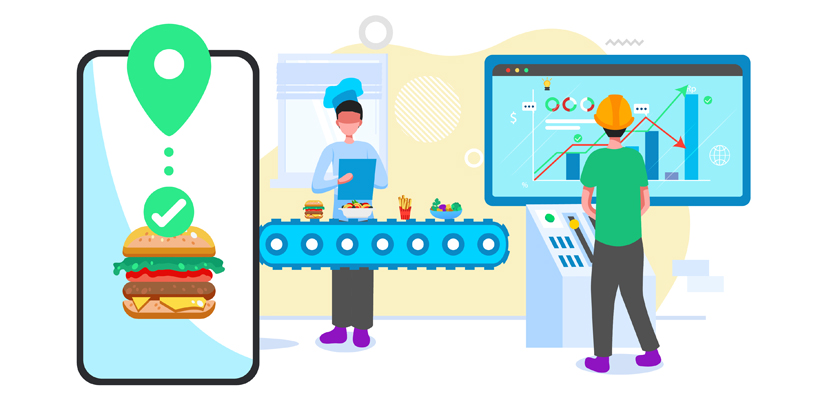Considering the pandemic has changed many things in lifestyle, businesses & various industries. One of the industries which suffered more was the restaurant sector, which was shut down for more duration & then we made online food delivery option the new normal. It changed the landscape of the restaurant industry, with many businesses forced to shut down or pivot to a delivery/takeaway model. With customers preferring doorstep food delivery over dine-in facilities, cloud kitchens, also known as dark kitchens, ghost kitchens, virtual restaurants, and satellite restaurants, are gaining popularity in the F&B sectors.
The reports by the global cloud kitchen market size valued at USD 51.96 Billion in 2020, is estimated to grow at a robust CAGR of 12.4% from 2021 to 2025. Many restaurateurs are now showing their interest in shifting from a traditional dine-in facility to set up a delivery-only business. today cloud kitchens are considered the smartest way to run a restaurant business.
If you're thinking of starting a cloud kitchen business, there are a few things you need to know. In this article, we'll give you an overview of the cloud kitchen business model and some tips on how to start a successful cloud kitchen startup.
What is a Cloud Kitchen?
A cloud kitchen is a delivery-only restaurant that has no physical space for dine-in basic it's completely on online orders placed through online food aggregators or an online ordering website or mobile app. A cloud kitchen is a commercial kitchen that is used solely for the preparation of food for delivery or takeaway. There are no dine-in facilities - customers order food via an online platform or app, and it is delivered to them either by the restaurant or a third-party delivery service.
How does it Cloud Kitchen Model work?
Cloud kitchens can be standalone businesses or they can be operated as an extension of an existing brick-and-mortar restaurant. Many restaurants are now opting to set up cloud kitchens in addition to their regular operations in order to reach a wider customer base and boost sales.
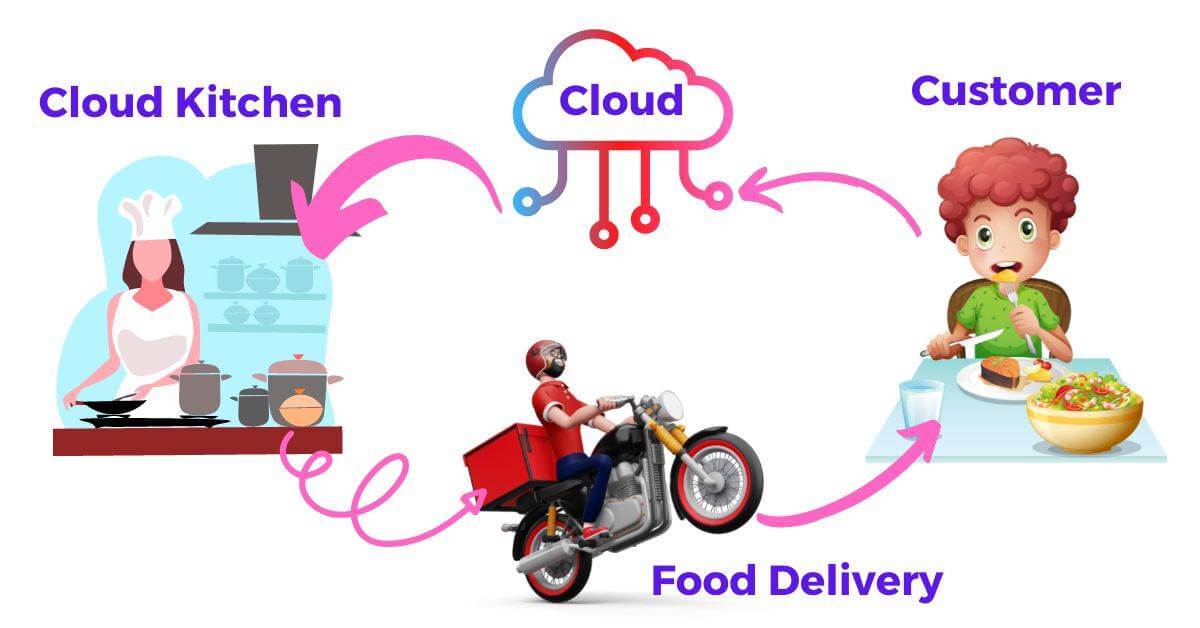
The cloud kitchen format gives the restaurant the flexibility to launch more than one brand or business using the same kitchen infrastructure. Multi-brand cloud kitchens let the restaurateur utilize the same kitchen area and resources to manage multiple brands.
The cloud kitchen business model is a delivery-only concept that has several advantages over traditional restaurants.
For customers, the main advantage is convenience - they can order food from their favorite restaurants without having to leave home.
For restaurants, the main advantages are lower overhead costs and the ability to reach a larger customer base.
Cloud kitchens also have a smaller ecological footprint than traditional restaurants because there is no need for dine-in facilities or table service.
Types of Cloud Kitchens
1. Ghost kitchens:
A ghost kitchen is a delivery-only restaurant that has no brick-and-mortar location or physical storefront. The food is prepared in a commercial kitchen and delivered to customers via a third-party delivery service such as Zomato, Swiggy, or Uber Eats.
2. Cloud kitchen aggregators:
Cloud Kitchen Aggregators: A cloud kitchen aggregator is a company that provides a platform for multiple restaurants to operate delivery-only kitchens from a single location. The aggregator manages the kitchen space and handles all aspects of food preparation, packaging, and delivery. Cloud kitchen aggregators typically take a commission on each order.
3. Standalone cloud kitchens:
These are small-scale cloud kitchens, which have limited menu items and have a small team of 4 to 5 employees the average area required for a standalone cloud kitchen is about 300 square feet. An independent cloud kitchen or a standalone cloud kitchens does not partner with any aggregators or delivery services. The owner of the kitchen manages all aspects of the business, from food preparation to delivery.
4. Virtual restaurants:
The virtual restaurant manages within a restaurant, basically this restaurant is listed on the online food apps or websites. They utilize the kitchen restaurants as virtual kitchens to facilitate this restaurant the delivery of food to the customers.
5. Multi-brand cloud kitchens:
Are basically analyses of the food consumption habits of people in a specific locality
6. Hybrid cloud kitchens:
This model includes a takeout restaurant combination with a cloud kitchen.
In 2019, there were around 5000 cloud kitchens in India but post the covid duration, the cloud kitchen got a boost to a large extent. Cloud kitchens got major support & management in collaboration with online food ordering apps and websites.
What do you need to start a cloud kitchen?
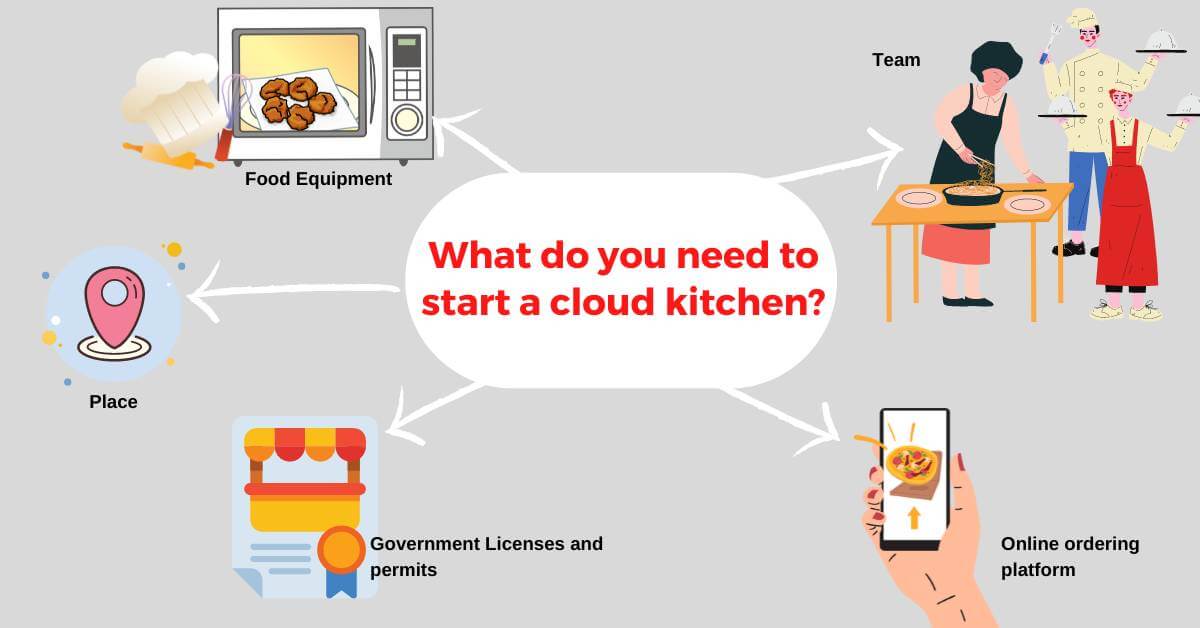
If you're thinking of starting a cloud kitchen, there are a few things you need to take into account:
1. Place: Cloud kitchens can be located in any type of commercial space, from warehouses to office buildings. The most important thing to consider is the proximity to your target market - you want to be sure that your customers will be able to get their food delivered quickly and without any issues.
2. Food Equipment: You'll need commercial-grade kitchen equipment, including ovens, stoves, refrigerators, and prep tables. If you're setting up a cloud kitchen from scratch, you can purchase used equipment or lease it from a restaurant supply company.
3. Team: You'll need at least one experienced chef to run the kitchen, as well as a few delivery drivers.
4. Government Licenses and permits: Check with your local government to see what licenses and permits you'll need in order to operate a food business in your area.
5. Online ordering platform: You'll need an online ordering platform or app where customers can place their orders. Many cloud kitchens use existing platforms such as Uber Eats, Grubhub, and DoorDash, but you can also create your own website or app.
How to start a successful cloud kitchen startup
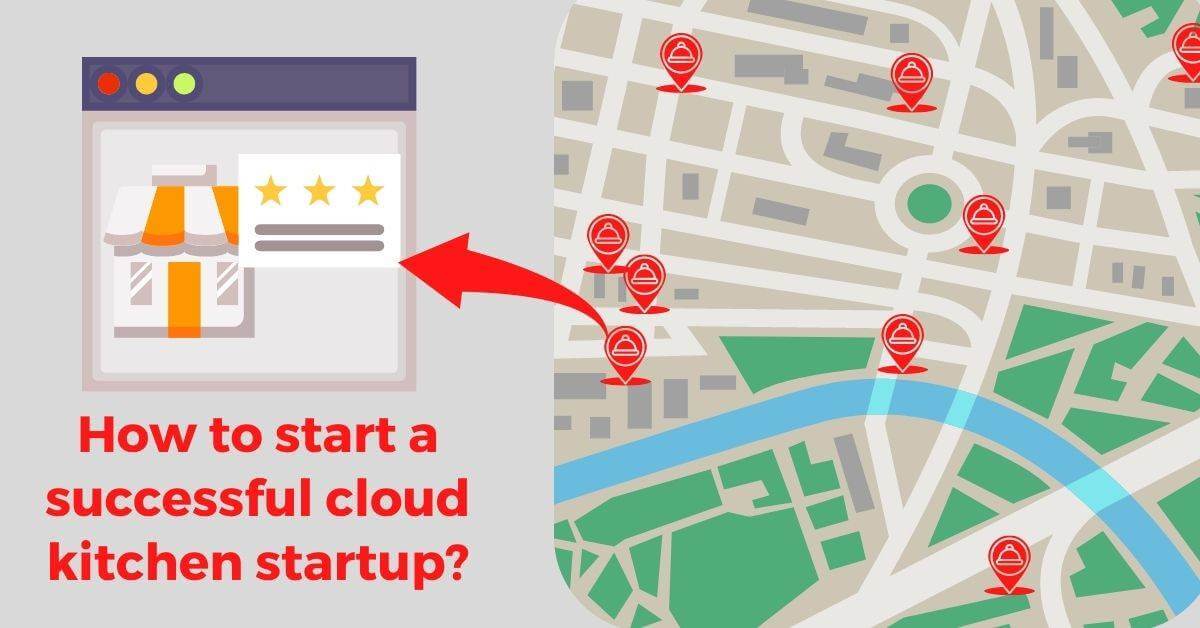
If you're thinking of starting a cloud kitchen business, there are a few things you need to do in order to set yourself up for success. Here are some tips/steps to starting a cloud kitchen:
1. Do your research:
The first step is to do your research and make sure you understand the ins and outs of the cloud kitchen business model. Build a business plan and track the progress of your competitors. This will give you a good idea of what's working and what isn't, and it will help you fine-tune your own operations.
2. Research the competition:
Take a look at what other cloud kitchens are doing in your area and see what you can do differently. What type of food are they serving? What is their pricing like? How are they promoting their business?
3. Find the right location:
In the case of a cloud kitchen, location is very important, good sanitation facilities, a constant supply of water and premises with a normal rent. The location should be one where you can expect massive demand for the type of food you would be offering.
You can start it with initial market research and an analysis of the location are very important. You should understand the demographics of the location to an understand the age groups, food-consuming habits and various preferences.
With finances permitting, you have to select a place with a parking facility. A frontal location i.e. street-facing will make your cloud kitchen not only very visible but easily accessible for everyone. You can safely start a cloud kitchen with an area of at least 350 square feet or for a more comfortable 500 square feet.
4. Create a menu
Develop a menu that will appeal to your target market. Be sure to include both food and drink items, as well as vegan and vegetarian options.
5. Licences
You can never set up a commercial business without a licence and the same applies to a cloud kitchen business as well. There are a few licences required in the first month of setting up a cloud kitchen, which are FSSAI license, GST Registration, Municipal health trade license, Fire licences
6. Invest in good quality Kitchen equipment:
One of the most basic requirements of every cloud kitchen is the types of equipment the kitchen has, and this equipment totally depends upon the cuisine or the concept of your cloud kitchen you want to run. These are the only products that you can calculate in the cost investment. Make sure you have all the essentials, such as ovens, stoves, dishwashers, and refrigerators.
7. Packaging
Packaging is one of the biggest concerns in setting up a cloud kitchen. No matter how well-cooked the food is unless it is handled well or packaged well.
8. Marketing plan
A registration with food websites like Burrp, Zomato, and Swiggy is a must as they have huge customers who place their orders through them. You can also place advertisements on social media like Facebook, Twitter, Instagram, and others by uploading information about your location, menu, images of the cuisine and more.
9. Hire experienced staff
The selection of the staff member for the kitchen is important for any kitchen. While the number of employees required is not much you have to ensure that they are well trained, efficient, and have the required skills to execute the functioning of your cloud kitchen.
10. Online connectivity
You will require a good phone line, seamless internet, and many mobile phones. You will have to be digitally active as the complete concept runs on the premise of a virtual kitchen.
11. Deliver outstanding customer service
Provide fast and friendly delivery service to ensure that customers will want to come back for more.
With the right planning and execution, a cloud kitchen can be a very successful business venture. Keep these tips in mind and you'll be on your way to success!
By following these tips, you'll be well on your way to starting a successful cloud kitchen business.
Most Popular Cloud Kitchen Business Models
Now that you know how to start a cloud kitchen business, it's time to take a look at some of the most popular cloud kitchen models.
Now that you know how to start a cloud kitchen business, it's time to take a look at some of the most popular cloud kitchen models.
1. The Order-Only Model: The order-only model is the most basic type of cloud kitchen business. In this model, customers can place orders online or over the phone, but they cannot dine in. This type of cloud kitchen is best suited for businesses that serve simple food items such as pizzas, sandwiches, and salads.
2. The Pick-Up Model: The pick-up model is similar to the order-only model, but it allows customers to pick up their orders from the kitchen rather than having them delivered. This type of cloud kitchen is best suited for businesses that serve food that can be easily packed up and transported, such as sandwiches, burgers, and sushi.
3. The Delivery-Only Model: The delivery-only model is the most common type of cloud kitchen business. In this model, customers can place orders online or over the phone, and they can have their food delivered to their home or office. This type of cloud kitchen is best suited for businesses that serve food that is easy to transport, such as pizzas, Chinese food, and Indian food.
4. The Hybrid Model: The hybrid model is a combination of the order-only and delivery-only models. In this model, customers can place orders online or over the phone, and they can choose to either have their food delivered or pick it up from the kitchen. This type of cloud kitchen is best suited for businesses that serve food that can be easily packed up and transported, such as sandwiches, burgers, and sushi.
5. The Franchise Model: The franchise model is a cloud kitchen business that is owned and operated by a franchisor. In this model, the franchisor provides the kitchen space, equipment, and staff, and the franchisee pays a monthly fee. This type of cloud kitchen is best suited for businesses that want to expand their reach and build brand awareness.
Now that you know the different types of cloud kitchens, it's time to decide which one is right for your business. Consider your business goals and your target market when making your decision.
If you're looking for a simple cloud kitchen business model that doesn't require much start-up capital, the order-only or pick-up models may be right for you. If you're looking for a cloud kitchen business that can generate a lot of income, the delivery-only or franchise models may be right for you.
Running a shared cloud kitchen
Running a shared cloud kitchen can be very beneficial for small food businesses. It can give you access to a larger customer base, shared resources, and economies of scale. But before you get started, there are a few things you should keep in mind.
The first thing to consider is your business model. There are two main types of cloud kitchen models - the multi-tenant model and the single-tenant model. In the multi-tenant model, multiple businesses share kitchen space and resources. This is often done through a platform like Kitchen United or CloudKitchen. In the single-tenant model, you lease or purchase your own kitchen space.
Next, you need to think about your target market. Who are your customers? What do they want? What are their pain points? Once you know your target market, you can start to think about what type of food you want to serve. Will you have a menu of your own dishes or will you allow customers to order from multiple restaurants?
Once you've decided on your business model and target market, it's time to start thinking about the practicalities of setting up your cloud kitchen.
Choosing the Right Technology for your Cloud Kitchen
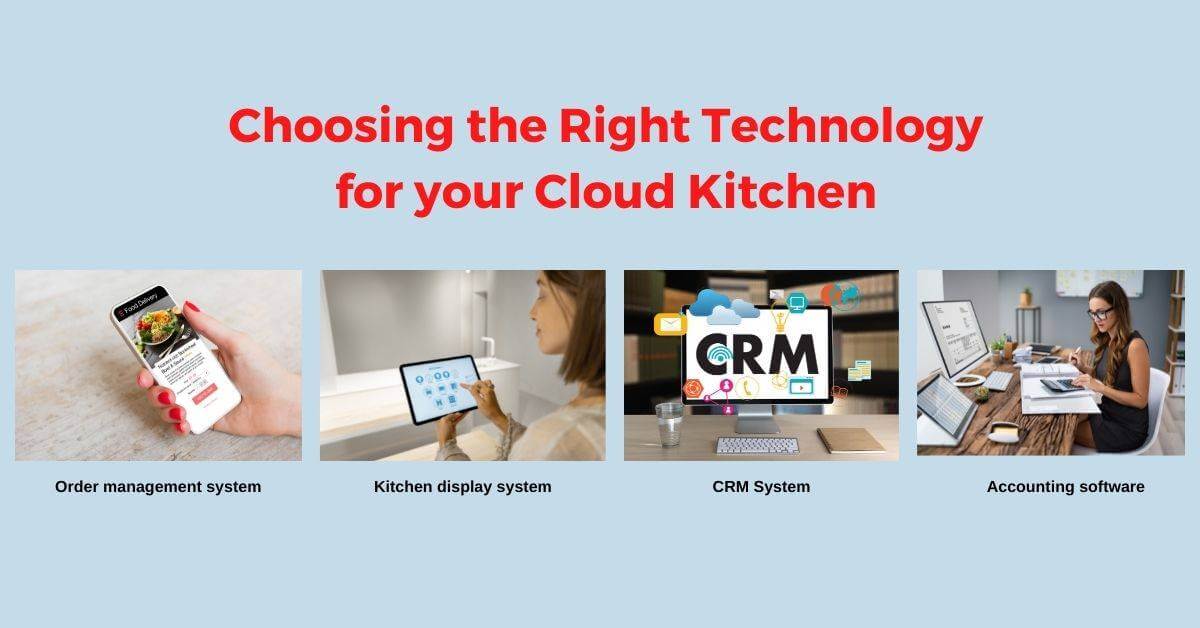
With the right technology, you can streamline your operations and make your cloud kitchen run more smoothly. Here are a few things to keep in mind when choosing technology for your business:
Order management system: An order management system (OMS) is a software that helps you track and manage orders. It can be used to track customer information, inventory levels, and delivery status. A good OMS will be user-friendly and scalable so that it can grow with your business.
Kitchen display system: A kitchen display system (KDS) is a software that helps you manage food preparation and cooking. It can be used to track recipes, ingredient lists, and cook times. A good KDS will be user-friendly and customizable so that it can be adapted to your specific needs.
Customer relationship management system: A customer relationship management (CRM) system is a software that helps you manage your relationships with customers. It can be used to track customer information, contact history, and order history. A good CRM will be user-friendly and scalable so that it can grow with your business.
Accounting software: Accounting software is a software that helps you manage your finances. It can be used to track income, expenses, and invoices. A good accounting software will be user-friendly and customizable so that it can be adapted to your specific needs.
By investing in the right technology, you can make your cloud kitchen more efficient and organized. This will help you save time and money in the long run.
Who Uses Cloud Kitchens?
There are a few different types of businesses that use cloud kitchens.
Restaurants: Some restaurants use cloud kitchens to prepare food for delivery or takeout. This can be a good option for restaurants that don't have the space or resources to prepare food on-site.
Grocery stores: Some grocery stores use cloud kitchens to prepare meals for customers. This can be a good option for stores that want to offer ready-to-eat meals but don't have the space or resources to prepare food on-site.
Meal kit companies: Some meal kit companies use cloud kitchens to prepare meals for customers. This can be a good option for companies that want to offer ready-to-eat meals but don't have the space or resources to prepare food on-site.
Is a Cloud Kitchen Right for Your Business?
A cloud kitchen can be a good option for businesses that want to offer ready-to-eat meals but don't have the space or resources to prepare food on-site. If you're considering a cloud kitchen, there are a few things to keep in mind:
The type of business you have: A cloud kitchen might not be a good option for every business. For example, if you're a restaurant that relies heavily on dine-in customers, a cloud kitchen might not be the best option.
The type of food you serve: If you serve complex dishes that require multiple steps to prepare, a cloud kitchen might not be the best option.
The size of your business: A cloud kitchen might not be a good option for a small business. This is because a cloud kitchen requires a significant investment of time and money.
The location of your business: A cloud kitchen might not be a good option for a business that's located in a rural area. This is because a cloud kitchen requires access to reliable transportation, which might not be available in a rural area.
If you're considering a cloud kitchen, it's important to weigh the pros and cons carefully. By doing so, you can make sure that it's the right decision for your business.
How to Maintain Cloud Kitchen Equipment
If you have a cloud kitchen, it's important to maintain your equipment. This includes regularly cleaning and inspecting your appliances. It's also important to keep an eye on your inventory levels and delivery status. By doing so, you can make sure that your kitchen is running smoothly and efficiently.
What are the licenses required for starting a cloud kitchen model in India?
The licenses required for starting a cloud kitchen in India vary depending on the state you're located in. However, there are a few common licenses that are required:
- Food license or catering license: A food license or catering license. is required in order to sell food. This license is typically obtained from the health department.
- Business license: A business license is required to operate a business. This license is typically obtained from the city or county where your business is located. You will also need to register your business with the relevant government departments, such as the tax office and the chamber of commerce.
- Liquor license: A liquor license is required if you plan on serving alcohol at your cloud kitchen. This license is typically obtained from the Alcoholic Beverage Control Board.
In addition to the general licenses and permits required to operate a business, you will also need to comply with specific regulations for running a food business. These regulations cover food safety, labeling, and packaging requirements.
Why are cloud kitchens the future of restaurants?
The COVID-19 pandemic has forced many restaurants to close their doors. Cloud kitchens provide a way for restaurant brands to continue serving their customers through delivery and takeout.
"Going by the reports, the global cloud kitchen market size that was valued at USD 51.96 Billion in 2020, is estimated to grow at a robust CAGR of 12.4% from 2021 to 2027smartest way to run a restaurant business."
Source: (posist.com)
Cloud kitchens are more efficient than traditional restaurants, as they don't have the overhead costs associated with running a dine-in establishment. This makes them a more cost-effective option for restaurant brands looking to survive the current economic climate.
The Pros and Cons of Starting a Cloud Kitchen
There are both advantages and disadvantages to starting a cloud kitchen business.
The Advantages of a Cloud Kitchen:
Affordable: The kitchen provides an affordable setup cost. It does not require any heavy expenses in setting up only the location should be good.
Flexibility: You can start small and scale up as needed.
Reach a wider audience: With delivery, you can reach customers who live further away from your location.
Low Costs: Compared to other traditional kitchens, which have to pay taxes, and overcome high maintenance costs, a Cloud Kitchen experiences fewer overhead costs. You don't need to rent or buy property for a physical location, and you can use shared commercial kitchen space to reduce your costs further.
Easy Expansion: The Cloud Kitchen offers a provision to expand your market according to your preference, and there is no extra overhead cost or planning involved in it.
Low Labour Costs: Cloud kitchens are very beneficial in terms of having a low labour cost compared to a restaurant or other traditional kitchens and along with the maintenance cost and tax facilities.
Reduced ecological footprint: Cloud kitchens have a smaller ecological footprint than traditional restaurants because there is no need for dine-in facilities or table service.
Increased efficiency: A cloud kitchen can help you increase you efficiency. This is because you'll have everything you need in one place, which will make it easier to prepare meals.
Scalability: A cloud kitchen can help you scale your business. This is because you can add more kitchens as your business grows.
High-Profit Margin business: The Cloud Kitchen is a virtual kitchen where there is a low-cost investment, low labour cost, and overall less maintenance in comparison to other restaurants, due to which the profit margin is higher.
Disadvantages of a Cloud Kitchen
High Competition in the market: Anyone can start it because of low investment.
Trust Deficit: Missing out on the organic local brand awareness created by a frontage. Since there is no dine-in, customers do not have memorable experiences to talk about, various restricting the most reliable marketing channel for local businesses.
Multiple Brands Have Multiple Problems: Every cloud kitchen has similar expansion plans – introduce a new food category or cuisine, preferably under a new brand name so that it doesn’t steal the light or tarnish the image of other established brands. While this move looks good preparing multiple cuisines to fall on that one chef, who might not be equipped enough to deal with different cuisines or types of food at the same time.
Lack of customer interaction: Unless you are actively involved in checking the reviews on the online aggregator platforms, there is no other way to see what your customers have to say about your menu. This lack of customer interaction can create a gap between what you think to be true and how your customers perceive your menu.
Difficult to stand out: With so many options available, it can be difficult to make your cloud kitchen stand out from the crowd.
Requires good marketing: You'll need to invest in good marketing and advertising to attract customers.
FAQ's on Cloud Kitchen Model:
The cost of starting a cloud kitchen can vary depending on the size and scope of your operation. However, you can expect to spend around $10,000 to get started.
No, you don't need a physical location for your cloud kitchen. You can use shared commercial kitchen space to prepare your meals.
You'll need to invest in good marketing and advertising to promote your cloud kitchen. Some of the best ways to do this include creating a website, launching a social media campaign, and using online food delivery platforms.
Some of the challenges of starting a cloud kitchen include increased competition and difficulty standing out from the crowd. Additionally, you'll need to invest in good marketing and advertising to attract customers.
Only you can decide if cloud kitchen is right for your business. Consider the pros and cons, as well as your business goals, before making a decision.
There are a few companies that have made a big impact in the cloud kitchen space. These include DoorDash, UberEats, and GrubHub.


